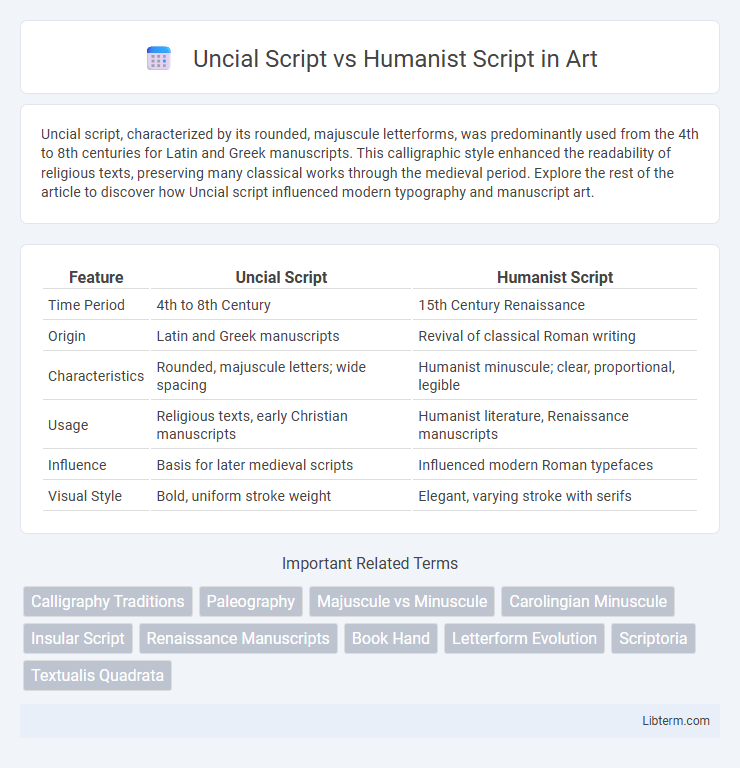Uncial script, characterized by its rounded, majuscule letterforms, was predominantly used from the 4th to 8th centuries for Latin and Greek manuscripts. This calligraphic style enhanced the readability of religious texts, preserving many classical works through the medieval period. Explore the rest of the article to discover how Uncial script influenced modern typography and manuscript art.
Table of Comparison
| Feature | Uncial Script | Humanist Script |
|---|---|---|
| Time Period | 4th to 8th Century | 15th Century Renaissance |
| Origin | Latin and Greek manuscripts | Revival of classical Roman writing |
| Characteristics | Rounded, majuscule letters; wide spacing | Humanist minuscule; clear, proportional, legible |
| Usage | Religious texts, early Christian manuscripts | Humanist literature, Renaissance manuscripts |
| Influence | Basis for later medieval scripts | Influenced modern Roman typefaces |
| Visual Style | Bold, uniform stroke weight | Elegant, varying stroke with serifs |
Introduction to Uncial and Humanist Scripts
Uncial script, prevalent from the 4th to 8th centuries, is characterized by its rounded, majuscule letters used primarily in Latin and Greek manuscripts. Humanist script, emerging in the 15th century during the Renaissance, revives classical Roman letterforms with clear, elegant minuscule characters designed for readability and aesthetic harmony. Both scripts reflect distinct historical contexts and cultural shifts in European manuscript tradition.
Historical Origins of Uncial Script
Uncial script originated in the 3rd to 8th centuries AD as a majuscule writing style primarily used by Latin and Greek scribes for religious manuscripts and codices. Its rounded, wide letterforms evolved from earlier Roman capital scripts and were designed for clarity and ease of reading on parchment. The script significantly influenced medieval book production, preceding the emergence of the Humanist script in the 15th century, which sought to revive and imitate classical Roman letterforms with greater linearity and precision.
Historical Origins of Humanist Script
Humanist script emerged during the early 15th century in Renaissance Italy, inspired by the clear and rounded forms of Carolingian minuscule, which was mistakenly believed to be a classical Roman script. Unlike the earlier Uncial script, characterized by its majuscule and rounded letterforms used from the 4th to 8th centuries, Humanist script reflected a revival of classical antiquity's humanistic values, emphasizing legibility and elegance in manuscript culture. This script played a foundational role in the development of modern Roman typefaces, marking a critical transition from medieval to Renaissance handwriting styles.
Key Visual Characteristics of Uncial Script
Uncial Script is characterized by rounded, majuscule letters with uniform thickness and minimal use of ligatures, making it highly legible and visually distinct from the angular, more compact Humanist Script. Its letterforms feature open bowls and a lack of serifs, contributing to a smooth, flowing appearance ideal for religious manuscripts and early codices. The consistent, upright posture and generous spacing between characters in Uncial Script contrast with the Humanist Script's emphasis on classical Roman proportions and calligraphic flair.
Key Visual Characteristics of Humanist Script
Humanist Script features rounded, open letterforms with consistent stroke weight, emphasizing clarity and legibility distinct from the more angular and condensed Uncial Script. Its characters typically display a moderate slant and clear separation between individual letters, reflecting Renaissance humanist ideals of harmony and proportion. The script's use of proportional spacing and ascenders with slight serifs further enhances its elegant and readable appearance.
Evolution and Influence of Uncial Script
Uncial script, originating in the 4th century, represents a key transitional phase in medieval manuscript development, characterized by rounded, majuscule letters that enhanced legibility for religious texts. Its evolution influenced the Humanist script of the 15th century, which revived classical Roman letterforms with greater clarity and proportionality, shedding the more ornamental aspects of uncial handwriting. This shift from uncial to Humanist script marked a crucial step towards modern typefaces, embedding classical aesthetics into Renaissance literacy and typography.
Humanist Script’s Impact on Renaissance Typography
Humanist script, developed in 15th-century Italy, significantly influenced Renaissance typography by reviving classical Roman letterforms, emphasizing clarity, balance, and proportionality. This script's human-centered design replaced the dense, angular forms of Uncial script, enabling easier readability and aligning with Renaissance ideals of beauty and harmony. Its adoption by early printers like Aldus Manutius set the foundation for modern serif typefaces, profoundly shaping Western typographic standards.
Cultural Contexts of Uncial and Humanist Scripts
Uncial script, prominent from the 4th to 8th centuries, was widely used in Latin and Greek manuscripts, reflecting the transition from Roman capitals to more rounded letterforms suited for religious and scholarly texts in early medieval Europe. Humanist script emerged during the 15th century Italian Renaissance, inspired by the revived interest in classical antiquity and ancient Roman inscriptions, emphasizing clarity, balance, and the revival of Carolingian minuscule for humanist ideals. The cultural contexts of Uncial highlight its role in the preservation of Christian texts within monastic communities, while Humanist script signifies the Renaissance humanists' pursuit of educational reform and classical revival.
Uncial vs Humanist: Comparative Analysis
Uncial script, characterized by rounded, majuscule letters, emerged in the 4th to 8th centuries primarily for religious texts, emphasizing clarity and ornamentation. Humanist script, developed during the Italian Renaissance in the 14th and 15th centuries, revived classical Roman letterforms with a focus on legibility and proportionality, influencing modern typefaces like serif fonts. The comparative analysis highlights Uncial's more decorative, majuscule style contrasted with Humanist script's refined, minuscule forms inspired by ancient Roman inscriptions, reflecting their distinct historical and cultural contexts.
Legacy and Modern Usage of Uncial and Humanist Scripts
Uncial script, originating in the 4th century, laid the foundation for medieval manuscripts and influenced modern calligraphy through its rounded, majuscule letterforms, which persist in liturgical texts and display typography. Humanist script, developed during the Renaissance, revived classical Roman letterforms and directly inspired the creation of modern serif typefaces such as Garamond and Bembo, shaping contemporary book design and digital fonts. Both scripts contribute to typographic heritage: Uncial preserves historical and religious manuscript traditions, while Humanist script underpins modern readability and aesthetic in printed and digital media.
Uncial Script Infographic

 libterm.com
libterm.com